A Guide to Identifying the 3 Most Common Pantry Pests in Davis County
By Thorn Team • Mar 17th 2022
While pantry pests do not bite people, they can cause extensive damage to your stored products, and certain pantry pests even come with health concerns. Use this guide to identify the 3 most common pantry pests.
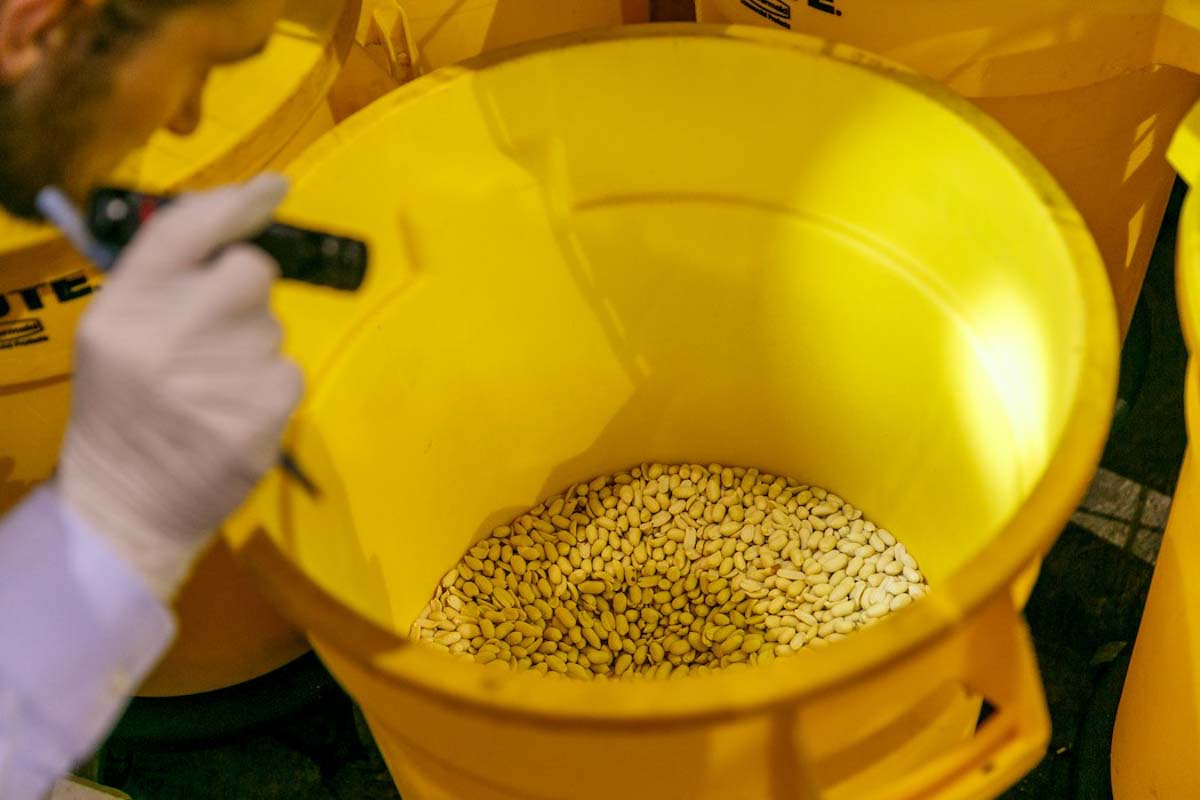
While pantry pests do not bite people, they can cause extensive damage to your stored products, and certain pantry pests even come with health concerns. Use this guide to identify the 3 most common pantry pests.
Pantry pests cause damage to grain kernels, leave webbing, insect parts and gritty powders in your baking supplies and can even cause products to develop strange odors, smells and colors. Sounds pretty gross, doesn't it?
Resolving pantry pest issues is most commonly a sanitation issue regardless of the pest(s) present. If you are dealing with a serious pantry pest infestation or an infestation on a larger scale, such as in a grain processing facility or school kitchen, identification of the specific pest in question can help in developing an effective treatment plan.
The 3 Most Common Pantry Pests and How to Get Rid of Them
Pantry pests are one of the most frequent indoor pest problems. The three most common pantry pests are:
- Pantry Moths
- Pantry Beetles
- Grain Weevils
It's important to know that these categories are general terms for pantry pests. There are far more specific classifications within these groups which we will cover in more detail shortly.
When it comes to resolving pantry pest issues in a residential or home kitchen setting, control methods are mostly the same:
- Identify and eliminate any sources of the infestation
- Tidy up your kitchen and pantry area (hold off on soap and water and opt for the vacuum instead)
- Have a plan to keep things clean and organized long-term
- Seal pantry products properly in tight-closing containers
- Buy only what you will use in 4-8 weeks and don't let pantry products sit
If you would like more info about getting rid of pantry pests and keeping them away, read our guide How to Get Rid of the 3 Most Common Pantry Pests.
How to Identify the 3 Most Common Pantry Pests in Davis County
The biggest damage caused by pantry pests is contamination. They leave fecal pellets, cast insect skins, dead insect parts and liquids in stored grain products. In more severe instances, they can cause flour to turn gray in color and mold more quickly. Due to their secretions, they create strange odors and compromise the taste of dried food items.
Identifying pantry pests will take a full inspection of the areas where you are noticing them. Some of the first noticeable signs of a pantry pest infestation are adult beetles or moths, shed insect skins or small worms. You may find this evidence on your counters, or in your baking goods, dried goods, and/or grain products. While not as noticeable as actual insects, you may also be noticing strange, gritty powder or webbing around the edges of open dried good bags.
While specific identification is not always necessary when it comes to getting rid of pantry pests, it can be helpful if the infestation is severe or if you're not sure where the pests are coming from in the first place.
One of the first signs of pantry pests may be finding adult pests in your grains, but it is actually not the adult moths that are doing damage, it's their larvae.
DEFINITION: A larva is a small worm or grub that is a part of the lifecycle of certain pests. These pests go through a process called complex metamorphosis. Complex metamorphosis is the process of an insect growing from egg to larva to pupa to adult.
Many types of insects have larvae (the plural of larva), including all the pantry pests covered in this guide. Larvae of various kinds are often called caterpillars as well.
The larval stage of many insect pests is the most destructive stage of their lifecycle. It takes a lot of energy to hatch, pupate, and become an adult! Most larvae have voracious appetites from the moment they hatch, and will happily gobble through any preferred food sources they can find.
Pantry Moths
Pantry moths are one of the most frequently reported pests of stored grains throughout the U.S.
The category of pantry moths includes many different types of moths, including:
- Indian meal moth
- Meal moth
- Mediterranean flour moth
Each of these moths are major pests of stored products such as seeds, grains, vegetables and fruits and they cause issues in a variety of places including homes and warehouse spaces. In southern areas of the US, pantry moths can be active year-round, but in cooler, more Northern regions, they are active through the summer and fall seasons.
SOME QUICK ADVICE FROM THORN: Do you notice a sudden increase in small moths inside when you turn on the lights in the evening? You may want to explore your pantry and make sure you don't have a pantry moth issue.
Moths are nocturnal and are attracted to light during hours of darkness. Seeing them inside your home, especially around light fixtures, can be an indication that there is potentially a bigger moth issue hiding somewhere close by.
Meal Moths, Indian Meal Moths and Mediterranean Flour Moths: What's the Difference?
Meal moths, Indian meal moths and Mediterranean flour moths are all Pyralid moths, meaning they come from the family Pyralidae. All three of these moths are found throughout North America and have many characteristics in common.
- Their larvae are major pests of stored grains, vegetables and fruits
- They cause problems in a variety of places including homes and warehouses
- These moths are nocturnal and attracted to light
- They're active through the summer and fall months in more Northern areas and year-round in warmer regions
The damage caused by these pests are very similar. Their primary differences are in appearance.
Indian Meal Moth
|
Meal Moth
|
Mediterranean Flour Moth
|
Pantry moths are a common problem throughout the United States, and Utah is no exception. If you're located in Utah and you need help solving a pantry pest problem, we're your local pest specialists and we're here to help!
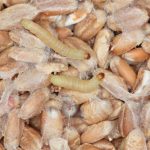
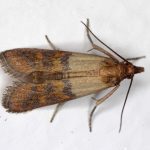
Indian Meal Moth Larvae(Left) and Adult(Right)
Pantry Beetles
When it comes to beetles in your pantry, there are a number of beetles that could be present, including:
- Flour beetles
- Sawtoothed grain beetle
- Larder Beetle
- Mealworm
- Carpet Beetle
- Drugstore Beetle
- Spider Beetle
And the list goes on! Many pantry beetles are so tiny, they are very good at forcing their way into a variety of storage areas and grain containers and hiding in little cracks and crevices.
SOME QUICK ADVICE FROM THORN: It can be very difficult to tell the difference between pantry beetles because they are so small and because pantry beetle larvae look the same.
Given that a number of beetle species enjoy munching their way through stored pantry products, make sure to regularly inspect and rotate your grains and keep them properly sealed up to avoid infestation.
Flour Beetles: The Confused Flour Beetle and the Red Flour Beetle
Both confused flour beetles and red flour beetles are part of the family Tenebrionidae. They look almost identical, especially during their larval stage, which can make them difficult to tell apart. When disturbed, they move quickly for cover, leaving distinct trails in the powder of flours and grains.
Flour beetles are:
- Reddish brown in color
- Just over 1/10th of an inch long
- Larvae start as small, whitish brown worms but turn more yellow in color and measure about 3/16th of an inch long once mature
Red flour beetles have been observed flying short distances. Even though the confused flour beetle also has wings, it has not been observed putting them to use.
These pests do not consume undamaged, whole grain kernels. They seek out cracked and damaged kernels and are more likely to be found in already processed flours or in the dust and food debris associated with the processing of grains.
SOME QUICK ADVICE FROM THORN: If pantry pests have been a recurring concern in your kitchen or business, it might be a good idea to have a professional place some pheromone traps once your space is clean and free of any infested items and spills. These traps will be placed and checked on a regular basis in order to determine what pantry pests are present and where.
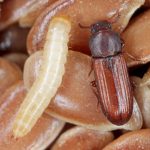
Confused Flour Beetle Larva and Adult
Sawtoothed Grain Beetles
Sawtoothed grain beetles are another tiny, stored product invader that is most found in stored products that are left undisturbed and rarely used. They are most active during the summertime, when adults can be found climbing around the pantry near items they have infested.
Sawtoothed grain beetles prefer humid, warm climates. They contaminate food items with their activity and also create an environment that encourages the growth of mold.
In terms of appearance and behavior, sawtoothed grain beetles are:
- Small and brown with a flattened body shape
- Six saw-looking teeth on the segment behind their head
- 1/8th inch long as larvae, yellow-white with a brown head
- Do not fly and are not attracted to light
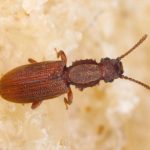
Sawtooth Grain Beetle Adult
Larder Beetles
Larder beetles infest a variety of materials and food items, such as:
- Meats, including cured meats like bacon
- Cheese
- Dried pet food
- Dried fish
- Stored tobacco
- Dried museum specimens, especially animal hides and items with natural hair
Larvae are an inch in length and look like dark, reddish, hairy little worms with a pair of spines on their tail end. Adults are smaller in length, somewhere between 1/4 to 1/3 of an inch. They have an oval shape and are dark brown in color with a yellow segment across the middle of their backs.
Larder beetles are often found overwintering in bark and come into homes in the spring through cracks and crevices on the outside of structures.
It is rare to find larder beetles feeding on stored food items, as they prefer dead insects and the skin or feathers of birds and animals that have died and become trapped in wall voids, attics and crawlspaces.
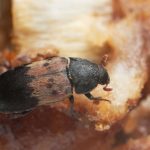
Larder Beetle Adult
Mealworms
The name of these pests come from the appearance of their wormy larvae, but eventually those little worms become adult beetles.
There are a number of mealworms, including:
- The yellow mealworm
- The dark mealworm
- The lesser mealworm
Mealworms are the largest stored pantry pest, but they are not the most damaging. They are nocturnal and prefer dark, undisturbed places.
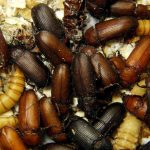
Mealworm Larvae and Adults
Grain Weevils
Grain weevils are very destructive grain pests, with the rice weevil being the most widespread.
When it comes to weevils, there are three main types:
- Rice weevil
- Granary weevil
- Maize weevil
The larvae of these pests develop inside the kernels of grains and then emerge as adults through tiny round exit holes.
Weevils (like most pantry pests) are very small, but don't be fooled by their size! They are incredibly damaging to stored products, and all infested sources will need to be removed if you hope to gain control of them long-term.
The most distinct characteristic of weevils is their snout. If you're not sure whether there are beetles or weevils in your pantry, look at their nose. If their snout is long, similar to an elephant's, you're dealing with a weevil problem.
SOME QUICK ADVICE FROM THORN: If you're struggling to get a handle on a pantry pest issue, contact a local pest control company to help investigate. If you're in Utah, Thorn in Davis County is here for you! We have extensive experience with pantry pest control in a variety of locations, from large commercial processing facilities to smaller residential pantries. No job is too big or small for the IPM specialists at Thorn!
About Thorn
Thorn is a Utah local pest management company. We are a QualityPro certified company which is a prestigious accreditation awarded to less than 3% of the pest management companies in the US.
Resources
About Thorn
Thorn is a Utah local pest management company. We are a QualityPro certified company which is a prestigious accreditation awarded to less than 3% of the pest management companies in the US.